Soltek NV400-L64: Purple, Practical, AND Performance!
by Wesley Fink on August 11, 2003 10:26 PM EST- Posted in
- Motherboards
Soltek NV400-L64: BIOS and Overclocking
Soltek uses the familiar Award BIOS on the NV400-L64. Our board was tested with the shipping v1.1 BIOS. The NV400 BIOS will be a pleasant surprise for enthusiasts who want to tweak the Soltek for the best possible performance. The board timing options and overclocking options are much more than you would expect on a low-priced motherboard.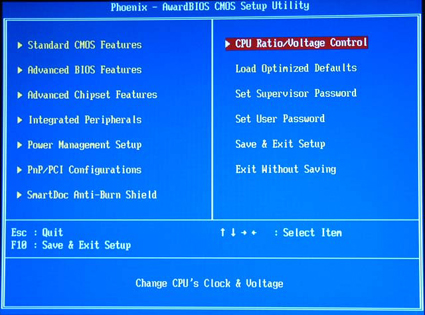
The Main BIOS Screen layout includes the standard options, plus CPU Ratios/Voltage Control, Advance Chipset Features for system timings, and SmartDoc Anti-Burn.
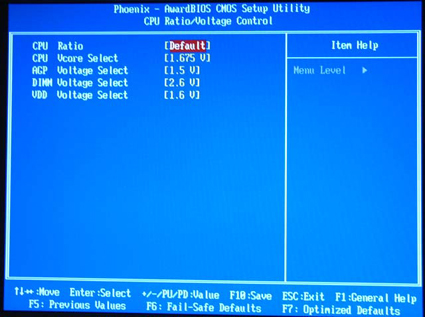
Voltage selection and CPU ratios are adjusted in the CPU Ratios/Voltage Control menu. Voltage adjustments are included for Core Voltage, DIMM, AGP, and also (surprisingly) adjustments for chipset (VDD) voltage.
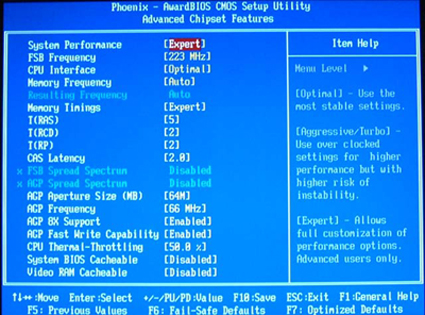
System and Memory Timings are adjusted in the Advanced Chipset Features menu. Unlike many other boards, the NV400-L64 has the adjustments for FSB in Advanced Chipset Features. A pleasant surprise is that Soltek includes a 'Fixed' option for PCI/AGP speed, which is adjustable from 50-100 AGP (PCI is half this value) in 1 MHz increments. While there is a full range of memory timing adjustments, one area of concern here is the Memory Frequency. The only option available is 'Auto', which means the memory can only be set to the memory speed programmed in the SPD. This will be a disappointment for many who like to adjust memory speeds for best performance.
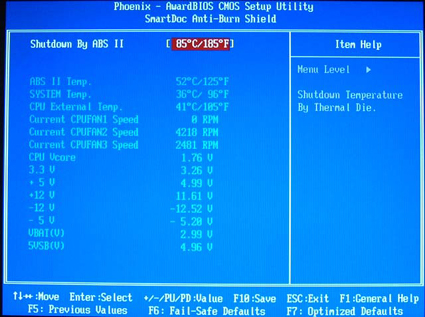
PC Health functions are featured in the SmartDoc Anti-Burn Shield section. Monitoring functions include System, CPU, and ABSII temperatures, fan speed monitoring for three on-board fan connections, Vcore, and Power Supply readings for all rails. The ABSII temperature monitoring appears to be reporting AMD sensor temperatures, as the reported temperatures are quite a bit higher than reported System temperatures. Soltek includes a Hardware monitoring utility on their installation CD for reporting the values in Windows.
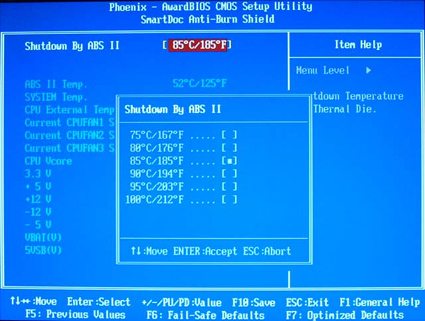
The Anti-Burn Shield II option has adjustments for setting the system shutdown temperature in the event of overheating. With the lack of attention paid to Athlon overheating problems in the past, we are pleased to see this concern addressed by Soltek on a board that will sell into the mainstream market.
BIOS options for the NV400-L64 are surprisingly complete. What we found here is very much in line with Soltek’s reputation of building economical boards that will still satisfy the computer enthusiast.
FSB Overclocking Results
With a complete selection of overclocking options on the Soltek, we had high expectations for the overclocking performance of the board. For FSB overclocking, the following setup was used on the NV400-L64:| Front Side Bus Overclocking Testbed | ||
| Default Voltage | Maximum Overclock | |
| Processor: | Athlon XP 2500+ (Barton Core) | Athlon XP 2500+ (Barton Core) |
| CPU Vcore: | 1.650V (default) | 1.775V (default) |
| Cooling: | Thermalright SK-7 with 80mm Thermaltake Fan | Thermalright SK-7 with 80mm Thermaltake Fan |
| Power Supply: | Powmax 350W | Powmax 350W |
The above overclocking setup at default voltage allowed us to reach a stable FSB of 215MHz. Considering that the DFI NFII Ultra reached a stable 223MHz at the same default settings, we were mildly disappointed in the Soltek overclocking performance compared to the best nForce2 Ultra 400 board. However, when we increased our voltage settings, we were able to reach a stable overclock of 225MHz at 1.775V. While this is not quite as good as the DFI NFII Ultra, it is very close, and it suggests that the Soltek design may require a bit more voltage than higher-end boards to reach the same overclocking heights. Our experience with higher voltages on VDD, in particular, suggests that very high overclocks can be reached with the NV400-L64 — if you are comfortable using higher voltages with this board. With the voltage and adjustment options available on the Soltek, and the low price of the board, we would not be at all surprised to see overclockers modding this board and pushing it to new performance levels. Out of the box, it is a decent, but not outstanding, performer at default voltage. With higher voltages, it becomes one of the best overclocking nForce2 boards that we have tested.
The Soltek NV400-L64 has a wide range of multiplier adjustments, available from 5X all the way up to 22X.










35 Comments
View All Comments
Wesley Fink - Tuesday, August 12, 2003 - link
#13 - The VIA KT600 board tests were earlier tests already completed by Evan Lieb with the 4.47 VIA Hyperion drivers . We reported what was used in those tests. The Hyperion drivers do not have any relevance to THIS review of the nForce 400.Turnip - Tuesday, August 12, 2003 - link
This is the least fair benchmark I ever remember having seen on AnandTech!To quote the last paragraph of the review, "It's hard not to get excited about a board that sells for about $70 and outperforms the majority of Athlon boards in gaming."
You're comparing 3D-based benchmarks using different graphics cards! Of course the benchmarks using the brand new whizzy cards are faster than the older benchmarks with old cards!
Regardless of whether you're updating this article with the new results now or not, this article should never have appeared in a publication of AnandTech's standing in this appalling condition in the first place!
- A long-time reader of AnandTech, who has never before seen such an unfair review.
Anonymous User - Tuesday, August 12, 2003 - link
Wesley-Just a little curious why you used all the updated drivers available except the Via Hyperion 4.48 drivers?
Wesley Fink - Tuesday, August 12, 2003 - link
Jeff7181 -In our tests at AnandTech, the performance of the nForce2 and nForce2 Ultra 400 is virtually the same at the same settings. The difference is that the Ultra 400 officially supports the 200FSB AMD processors, and they generally overclock better as a result.
As stated in #10 above, we have completed a retest of recent reviews with our new ATI 9800 PRO video card standard, and those will be posted in this review later today. Since the difference in nForce2 and nForce2 Ultra 400 is 200 CPU/bus support and overclocking, we did not retest the older nForce2 chipset boards.
Jeff7181 - Tuesday, August 12, 2003 - link
This review is lacking... where's the benchmarks for the popular motherboards like the A7N8X Deluxe, NF7-S, and 8RDA+ ?!?!? I don't care if a new nForce2 400 Ultra whatever the hell they call it now is faster than a KT600 chipset... I want to know if it's faster than the previous generation of nForce2 motherboards. Quit slackin off Anand.Wesley Fink - Tuesday, August 12, 2003 - link
All of our benchmarks have been updated using the ATI 9800 as the reference video card, and you will see updates in this article very shortly. The text changes will go up first, so bear with us until all the updates are up.Anonymous User - Tuesday, August 12, 2003 - link
Stability? Sound? Are you joking?You can also get an Epox 8RDA+ with those same features for $15 more and it'll come with Serial ATA, nForce sound (much better than any VIA sound), better overclocking potential, and most likely better drivers. Push comes to shove, who would any sane person choose, VIA or NVIDIA? LOL, as if I should have to answer that.
Face it, KT600 motherboards are worthless unless you're a VIA whore.
Anonymous User - Tuesday, August 12, 2003 - link
I have an Asus A7N8X-X, and this mobo has a nForce2 400 chipset, with single chanel memory. Processor, XP2600(fsb333) and 1GB DDR333. If it is faster than nForce2 ultra 400 (dual chanel), or not... that I don't know. But I was surprised with the speed of my system.Anonymous User - Tuesday, August 12, 2003 - link
Lets See what issues this chipset brings,For 15$ more KT600 With integrated SATA &
better sound (& probably stability) is a better
choice without a doubt.
Btw..What is it with you guys & Corsair...Looks
Like you have a "Nice" setup with them huh ..
Anonymous User - Tuesday, August 12, 2003 - link
#2 what are you talking about? Why would anyone choose a KT600 motherboard that is slower and overclocks poorly for more money just because you can get onboard SATA that does absolutely nothing for performance? Puhlease.